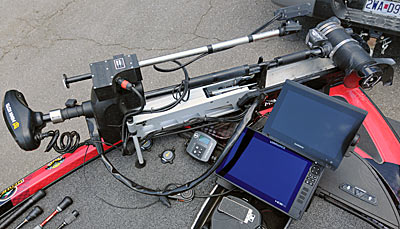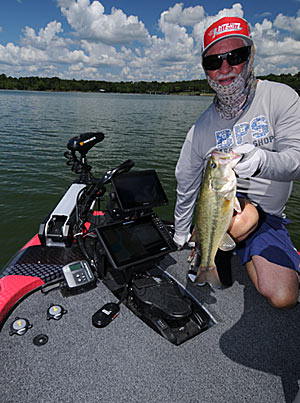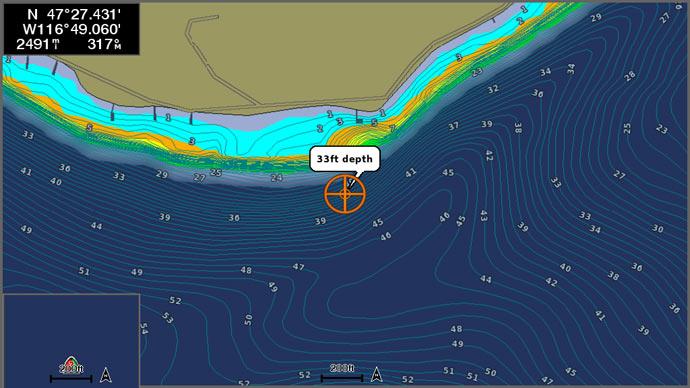
Your eyes can usually pick out where you need to fish in shallow water, but you need some visual aids when you search for bass in deep water.
“Electronics are essential for fishing deep,” says 12–time Bassmaster Classic qualifier Stacey King. “Learning to use electronics in today’s fishing world is extremely important. You need to know what is under you, and with the new forward-looking sonar, you can look out in front of you and see what you are coming up on. It is so critical to be able to find structure and also find baitfish. If you can find the baitfish, then you can find bass.”
While idling over deep water, King relies on the side and down scan features of his console Lowrance unit. He sets up his unit to scan both sides of the boat and sets the scanning range to 50 feet. “If I put it out much farther than that, it seems like I lose a lot of definition,” King says. “If I am trying to find something close to the boat, I will cut down that to even 40 feet.” King sets the background of his side imaging in the green palette, which he claims is best for showing details on the screen.
King suggests his Lowrance unit’s factory setting for sensitivity is “pretty good,” so he keeps the sensitivity on the default setting most of the time. “Sometimes I will bump that up just a bit to get a better picture of what I am looking at down on the bottom,” King says.
Bumping the sensitivity too high will cause a lot of clutter on the screen. “You will get interference if you get too much power coming into the unit,” King says. “It seems like a little more than factory settings is where I like to run my units.”
King constantly searches for structure, baitfish, and bass with his electronics when scanning from the console or front deck. “You may find one or two of those things or all three. You never know for sure,” King says. “Typically, if you find baitfish, you will find bass around them. But there are times you find bass, and there is no bait around, and you are always looking for good structure whatever the case may be, whether it is timber or rocks or breaks or grass.”
When scanning from the front deck, King relies heavily upon the Panoptix LiveScope feature of his Garmin sonar. He prefers the blue palette for the screen background on his Garmin unit. “It seems like the fish pop out in a bronze color on the blue background, and I can see them well,” he says.

The Missouri pro sets the LiveScope's range to 40 or 50 feet. “It seems like if I get much farther than that, the image is not as definite in detail,” he says.
King sets the unit’s gain (sensitivity) at 65 to 75%. “You have to play with that depending on how much clutter and stuff you have in the water,” he says. “If the water is a little dirtier, you may not need as much because you will get a lot of resistance. If the water is clear, you can turn that gain on up. That is a feature that you just have to play with.”
Setting the depth range on his LiveScope depends on how deep King will be fishing. “If I am fishing deep water in the lower end of Table Rock Lake, I am going to set the depth range where I am sitting my boat in 30 to 50 feet,” he says. “If I am fishing shallow up in one of the river arms, I may set it at 25 or 30 feet because I know the fish will be in that 10 to 15-foot range.”
Installing a Rite-Hite Turret on his trolling motor has helped improve King’s scanning deep with LiveScope. The Turret is an independent shaft motor-driven LiveScope Transducer Holder available for the mounts of Minnkota Ultrex, MotorGuide Tour, Lowrance Ghost, and Garmin Force trolling motors. “It is just basically a game changer,” King says. “We have all fallen in love with the forward-looking sonar, but the problem is that transducer is mounted on the side of the trolling motor, and when you turn the motor in the wind, it also turns your beam. The Turret allows you to scan completely around the boat no matter which way your trolling motor is pointed.”
The Turret features a foot switch on the deck for turning the transducer in any direction, and an arrow on the top of the Turret indicates which direction the LiveScope transducer is pointing. “It has helped me catch so many fish that I wouldn’t normally have caught because the wind was blowing hard, but I was still scanning around and not having to worry about the transducer on the trolling motor,” he says.
When fishing deep in the summertime, another key to finding bass in deep water is to scan for the thermocline—the transition layer of water between the hot surface water and cooler deep water below. Bass and baitfish congregate in this layer because it is cooler than the surface water and contains more oxygen than the cooler deep water. “It is crucial in hot weather to know where the thermocline is because it is going to tell you where most of the baitfish and bass are in the lake,” he says.
King notes the thermocline will show up on your electronics as about a 5- to 6-foot band of clutter made up of bass, baitfish, and phytoplankton.
The depth of the thermocline determines whether King presents his lures vertically or horizontally to bass. For bass in deep thermoclines, King usually presents his lure vertically; if the thermocline is less than 20 feet, he makes horizontal presentations.
His LiveScope transducer lets him keep track of his lure and ensure it stays in the thermocline throughout his presentation. “If you spot some fish in the thermocline, you can cast out past them, and if you can keep the lure in that LiveScope beam, you can watch your bait come right back to the fish,” King says. “Then, if you are too high, you can slack off on your retrieve and drop the lure a little bit or vice versa. If your lure is too deep, you can bring it up.”
Your electronics become your eyes for finding and staying on schools of deep bass in the summer heat.



